|

     
A vibrant new city born
of dramatic change...
|
|
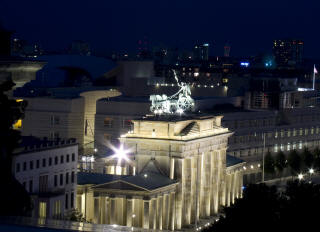
Brandenburg Gate night view from Reichstag Dome |
Berlin continues to
evolve. Since my
last trip to Berlin in 1998 the city has all but
obliterated any differences between what used to be very
distinct east and west sections. It's a new city almost
everywhere. Even the old monuments have gotten a
facelift of one sort or another, like the new glass dome
on top of the Reichstag. Back in 1998,
construction cranes filled the skyline while the city
streets and subways seemed to be in a constant state of
flux. Since Berlin is a big, expansive city, it's not generally "walkable".
Yet now in 2010, it moves very efficiently with an urban
transportation system and infrastructure that would be
the envy of most large cities. It feels very safe on the
streets and in the metro, even late at night. |
|
Saturday, August 14th -
Berlin at night
Our train from Frankfurt pulled into Berlin's massive new central station at
4:30pm. We connected on the new U55 line to the Brandenburg Gate and
walked the few blocks to our hotel, the excellent
Berlin Marriott. After a leisurely turnaround there we metroed
across town to the southwest corner of Tiergarten park where we
bought some supplies, ate dinner and joined the Saturday night crowd
at the bar for drinks at the Hard Rock Cafe. Before heading back to
our hotel for the night, we snapped
some night shots of the
Kaiser Wilhelm church (first picture below). |
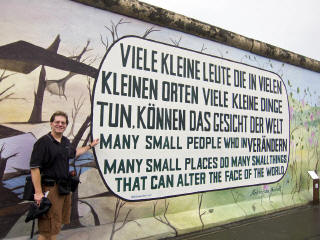
Berlin Wall - East Side Gallery - many small people... |
|
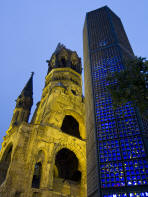
Kaiser Wilhelm
church old/new |
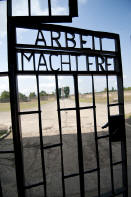
Sachsenhausen gate |
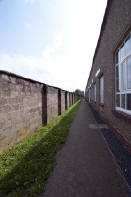
Sachsenhausen walls |
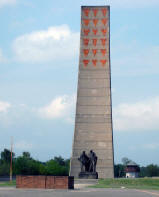
Sachsenhausen
memorial |
|
Sunday, August 15th -
Sachsenhausen concentration camp memorial & the East
Side Gallery
After breakfast at the hotel we bought ABC wide region metro passes and
rode the S1 line ~50 minutes to Orienburg. Having visited
Sachsenhausen
back in 1998 and getting lost in Orienburg, I was armed with
maps and a GPS this time. Despite tour book assurances that the
route to Sachsenhausen is well marked - it's actually not marked at
all until you are several blocks from the station. The important
turn is the first one - turn right on the road in front of the train
station. The walk is about a mile and there is a bus as an
alternative, but it doesn't run very often, so Craig and I walked
both directions. The
Sachsenhausen
concentration camp memorial has changed a lot since I visited it
12 years ago - cleaned up and better organized, but in my opinion
that really doesn't fit it well. The experience this time was less
eerie, but less moving as well. What happened here during both the
Nazi's reign and the Soviet years that followed is important to see
and remember, yet difficult to comprehend in terms of its sheer
magnitude. We entered the camp through the infamous "Arbeit macht
frei" (work will make you free) gate (second picture above) that is
also at other concentration camps. The grounds are very large and
many of the original buildings are still there in their original
state or have been restored. Several fences encircle the camp (third
picture above) and there is a large memorial in the center to the
camp's liberators (fourth picture above).
Returning to Berlin in the afternoon on the S1, we connected across
town to the Ostbahnhof station and walked toward the river to visit
the East
Side Gallery. The East Side Gallery is the longest remaining
piece of the Berlin Wall, decorated after the fall of the Wall in
1989 by various artists in themes of freedom and unity. It's been
restored several times since then. For some reason this is not a
major tourist spot - even hard to find on the web, but for me it was
a highlight of the city just as it was 12 years ago. We walked its
whole mile length (large picture top of page right and first two
pictures below). My sense is that Berliners want to forget it ever
existed and the relatively few younger people who have heard of it
don't really understand what it was and what it stood for. In some
spots in Berlin, but not all, there's a brick marking line in the
pavement where the Wall once stood. There were actually two walls,
one inside the other (third picture below), that defined a no-man's
land that had to be crossed under fire to escape. Returning to our
hotel around sunset, we took the short walk to the newly marked spot
of
Hitler's bunker (fourth picture below). The location, which is
now just a parking lot in front of an apartment building, had never
been marked until 2006 because of fears that it would become a
lightning rod for neo-fascists. |
|

Berlin Wall East
Side Gallery |

Mary Mackey's panel |

Front & back walls |

Hitler's Bunker
site |
|
Monday, August 16th -
Central Berlin
After a late breakfast at the hotel we walked east through the "Topography
of Terrors", which is both a short remaining section of the
Berlin Wall and the site of the infamous SS headquarters during
World War 2 (first picture below). Continuing a few blocks farther
east we visited the
Checkpoint Charlie Museum (second picture below), which while
crowded, was worthwhile. Most of the exhibits have to do with the
ingenious ways people escaped to West Berlin. We walked back to the
Reichstag, but seing the long line to enter the Dome (third picture
below), we decided to come back in the evening when the line might
be shorter (it wasn't). After a short stop at the new and unique
outdoor
Holocaust Memorial (fourth picture below), we metroed and then
hiked over to Museum Island. |
|

Topography of
Terrors |

Checkpoint Charlie |

Reichstag facade
mid-day |

Holocaust Memorial |
|
Museum Island is a concentrated area with five of Berlin's
most notable museums situated between the River Spree and
Kupfergraben. We bought an all-museum pass and started with
the Bode Museum, which was supposed to house the massive
Egyptian collection - but it didn't. Leaving the Bode after a
short visit, we walked across the bridge for what turned out
to be a terrible lunch at a nearby outdoor cafe, then headed
back across the river to the Neues Museum, which did hold the
extensive and well organized Egyptian collection. Regrettably,
they didn't allow pictures in the room with the famous
bust of Queen Nefertiti, which dates from 1345BC. We spent
quite a while in the Neues museum and by the time we left we
both felt all "museumed out", so we didn't visit the rest of
the museums on the island. Instead, we hiked to the Berliner
Dom (first picture below) for a quick visit and then over to
the
Radio Tower. The line to get to the top was hours long, so
we decided to punt on that and metroed back to our hotel for a
snack and some drinks. Switching our camera gear to tripods
and night shot lenses, we walked to the
Reichstag around sunset where the line for the Dome was at
least as long as it was earlier (second picture below). It
took an hour and a quarter in line, but we both agreed that
our visit to this architecturally unique dome was very
worthwhile (third and fourth pictures below and large picture
top of page left). We ended the evening with a late dinner
near our hotel and then packed for our train to Prague the
next day. |
|
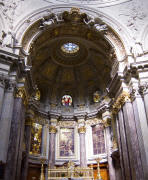
Berliner Dom
interior |
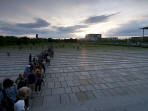
Reichstag Dome line
at sunset |

Reichstag Dome top
level |
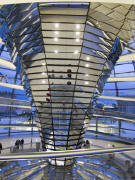
Reichstag Dome
spiral |
|
Click on the button below to
continue with us to the Czech Republic
 |

     
Mackey Group, Inc.
© 2002 - 2010
|
|